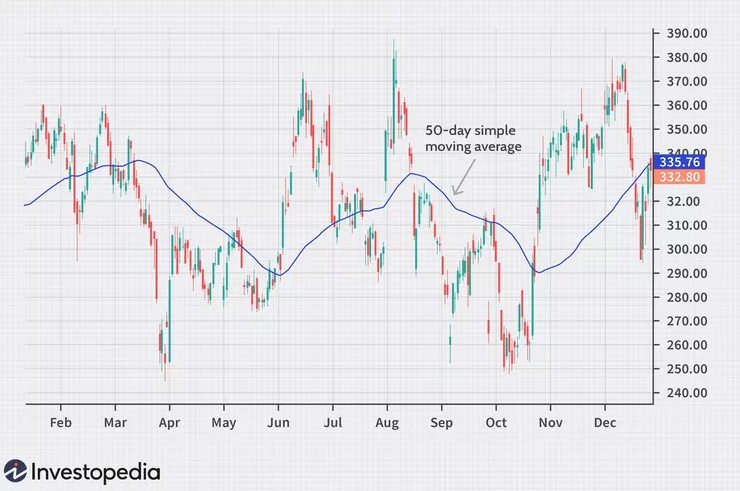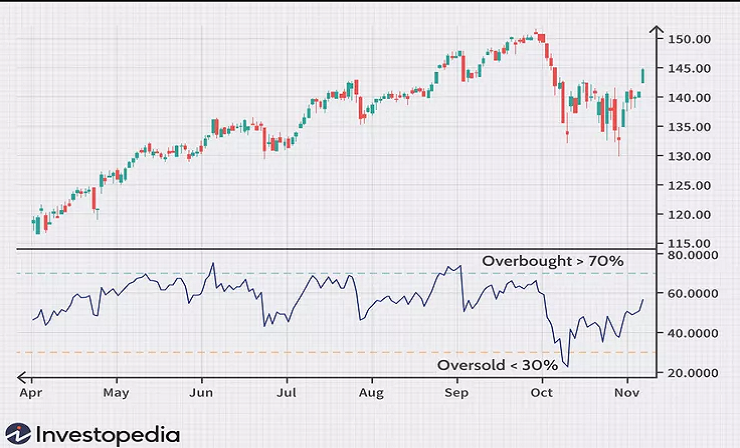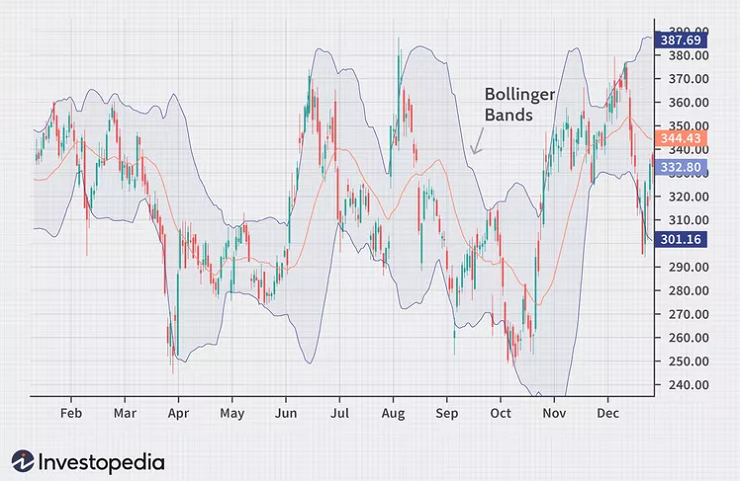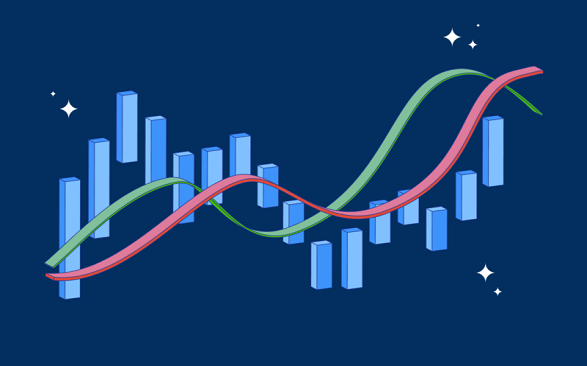Introduction
Crypto trading is now a hot topic on the internet as cryptocurrencies have grown in popularity over the years. Many people all over the world want to get involved and profit from investing in crypto assets. If you are one of these people, do not forget that the crypto market can be very volatile and uncertain.
And this is why it is pertinent to have a solid understanding of the various concepts that can help you make informed trading decisions. The knowledge of fundamental analysis, technical analysis, and chart indicators, therefore, becomes a necessity for any trader or investor with profitability in mind.
So what’s your go-to technical analysis indicator? Do you have a favorite that helps you trade profitably? If not, or if you want to diversify your library of trading indicators, then you have come to the right place.
In this article, we examine the top five technical analysis indicators you should know about in 2023. These indicators have proven effective in helping traders navigate and differentiate themselves in the constantly volatile cryptocurrency market. Stick around and see what indicators you can use to beat the game this year 2023 and beyond.

Understanding Technical Analysis and Its Importance
Before we talk about the technical analysis indicators you can use to predict the cryptocurrency market, it’s necessary to know what technical analysis entails and its importance in crypto trading.
Technical analysis plays a very vital role in a profitable crypto trading journey. Many people think crypto trading is just all about buying coins/ tokens anytime and whenever they feel like it. They often fail to realize the volatility of the crypto market. Prices can fluctuate dramatically within a short period, and without a proper understanding of market trends and patterns, it is almost impossible to predict the right time to buy and sell digital assets.
To avoid this, you need technical analysis.
What is Technical Analysis?
Technical analysis (TA) involves using historical price data and various charting tools to identify patterns and trends that can help traders make informed decisions about the right time to enter and exit trades.
Without a proper trading strategy, you can end up losing your entire savings while trying to make profits off crypto trading. Don’t make the mistake of thinking that crypto trading is just about buying and selling tokens—it’s much more complex than that. By understanding the market trends and applying technical analysis techniques, you can make more profit-giving judgments, and minimize your risk and exposure level in the crypto market.
Having understood the importance of technical analysis, shared below are some of the top and widely-used technical analysis indicators.
Top 5 Technical Analysis Indicators
Here are some of the top technical analysis indicators you should learn if you want to stay atop the trading game.
1. Moving Average (MA)
What is a moving average (MA)? Simply put, a moving average is a technical analysis tool that helps traders spot trends by smoothing price data over some time. There are different types of moving averages, including Simple Moving Averages (SMA), Exponential Moving Averages (EMA), and others. The main difference between these types is how they are calculated and how recent price data is weighted.
One way to use moving averages in cryptocurrency trading is to set up a crossover strategy. This involves drawing two Moving Averages with different periods on the chart and waiting for the shorter-term MA to cross over to the longer-term MA. When the short-term MA is above the long-term MA, it could be a buy signal. If it breaks below the long-term moving average, it could be a sell signal.
Using MA can help you spot trends and make profits off early crypto calls. But it is important to note that the moving average is a lagging indicator. This means it may not always provide timely signals. It is also not suitable for detecting short-term price movements.

2. Fibonacci Retracement
Fibonacci retracements are a method of identifying potential support and resistance levels in a market by drawing horizontal lines across key Fibonacci levels on a chart. These levels are derived from the Fibonacci sequence, which is a series of numbers with a mathematical relationship.
To use Fibonacci retracements in cryptocurrency trading, a trader can draw horizontal lines on a chart by first identifying the highs and lows of a trend. Then connect the dots and draw horizontal lines at the major Fibonacci levels of 23.6%, 38.2%, 50%, 61.8%, and 100%.
While Fibonacci retracement is a great analysis tool, it is also a subjective tool and key levels may not always turn out as expected. It is also not suitable for recognizing long-term trends. While it has its limitations, it can be a valuable addition to a trader’s toolbox when combined with other analytical techniques.

3. Moving Average Convergence Divergence (MACD)
The Moving Average Convergence Divergence (MACD) indicator is a technical analysis tool I often use in my crypto trading. MACD is a momentum indicator that determines the direction and strength of a trend by comparing the divergence between two moving averages. You can calculate it by subtracting the 26-period exponential moving average (EMA) from the 12-period EMA.
One way to use the MACD in cryptocurrency trading analysis is to look for divergences between the MACD and an asset’s price. If the MACD is making higher highs while the price is making lower highs, it could be a bearish divergence and a potential sell signal. On the other hand, if the MACD is making lower lows while the price is making higher lows, it could be a bullish divergence and a potential buy signal.
The MACD can help you make more informed decisions. But you must be careful. MACD can also provide false reversals. Sometimes a reversal signal from a MACD divergence doesn’t mean that a major reversal is imminent. This could mean a temporary pause before the trend resumes.

4. Relative Strength Index (RSI)
Another momentum TA indicator is the Relative Strength Index (RSI). The RSI is a momentum indicator that measures the magnitude of recent price changes to help determine overbought or oversold conditions in a market. It is calculated using the average profit and loss of an asset over a given period.
To use the RSI when trading cryptocurrencies, a trader can plot the indicator on a chart and observe the resulting line. RSI values range from 0 to 100, with values above 70 generally considered overbought, while values below 30 are considered oversold.
You can use the RSI in cryptocurrency trading to find the divergence between the RSI and the price of an asset. If the RSI is making higher highs while the price is making lower highs, it could be a bearish divergence and a potential sell signal. On the other hand, if the RSI is making lower lows while the price is making higher lows, it could be a bullish divergence and a potential buy signal.

5. Bollinger Bands
The last tool but not the least is the Bollinger Bands. What are Bollinger Bands and how can traders use them for technical analysis?
Bollinger Bands are a volatility indicator drawn on a chart to help traders spot potential buying and selling opportunities. They consist of a middle line (20-day moving average), an upper limit, and a lower limit. The upper and lower bands represent a certain amount of standard deviation above and below the center line, which helps indicate overbought and oversold conditions in the market.

How To Use Bollinger Band Indicator
To use Bollinger Bands in cryptocurrency trading, you need to draw Bollinger Bands on a chart and observe the resulting lines. When an asset’s price hits or crosses its ceiling, it could indicate an overbought condition and a potential sell signal. If the price touches the lower band or breaks out, it could indicate an oversold condition and a potential buy signal.
One benefit of using Bollinger Bands is that they can help you identify overbought and oversold conditions and potential breakout opportunities.
A good way to use Bollinger Bands is to look for a “squeeze” which occurs when the Bollinger Bands contract and price action become relatively tight. A squeeze can indicate that a breakout is imminent and traders can look for potential buy or sell opportunities depending on the direction of the breakout.
Read Also: Understanding the Metaverse and Top Metaverse Coins in the Crypto Market
Conclusion
Knowing and applying technical analysis as a trading strategy can be very beneficial to the crypto investor as it can provide valuable insights into the market and help profitable decision-making.
While this article has carefully discussed five (5) technical analysis indicators, they are not limited to the above-mentioned. Meanwhile, TA alone may not be enough to profitably navigate the crypto market. Therefore, a combination of fundamental analysis and technical analysis won’t be a bad idea.
On the whole, this article has hopefully provided a useful overview of TA indicators and equips you better as you incorporate them into your trading techniques.
Credit: Ndianabasi Tom
Image credits:- Moving Average Chart; Fibonacci Retracement; Relative Strength Index:: Images by Sabrina Jiang © Investopedia 2021; Moving Average Convergence Divergence (MACD); Bollinger Bands: Images by Sabrina Jiang © Investopedia 2022
Discover more from Crypto Asset Buyer
Subscribe to get the latest posts sent to your email.




